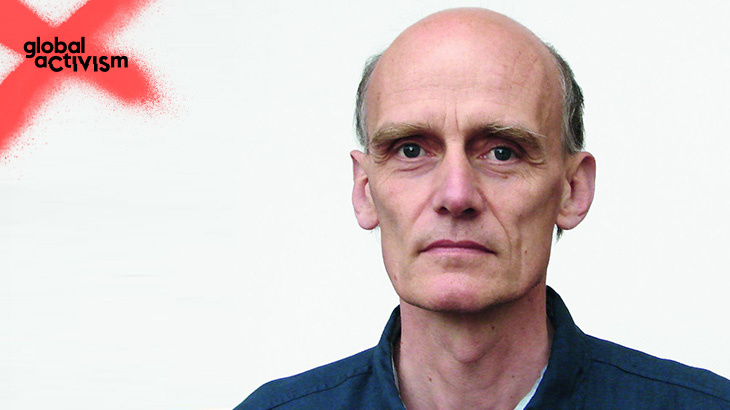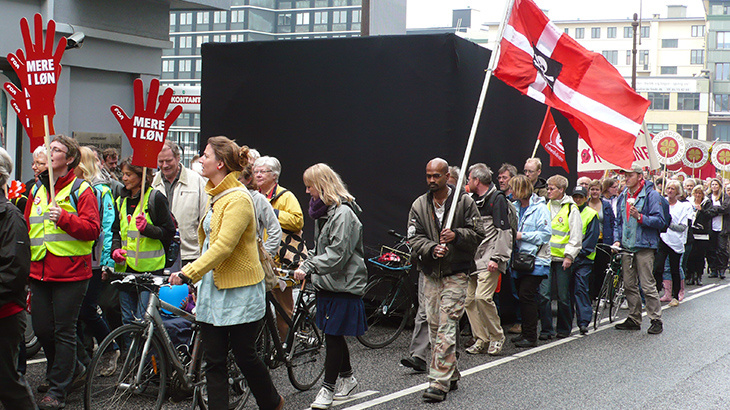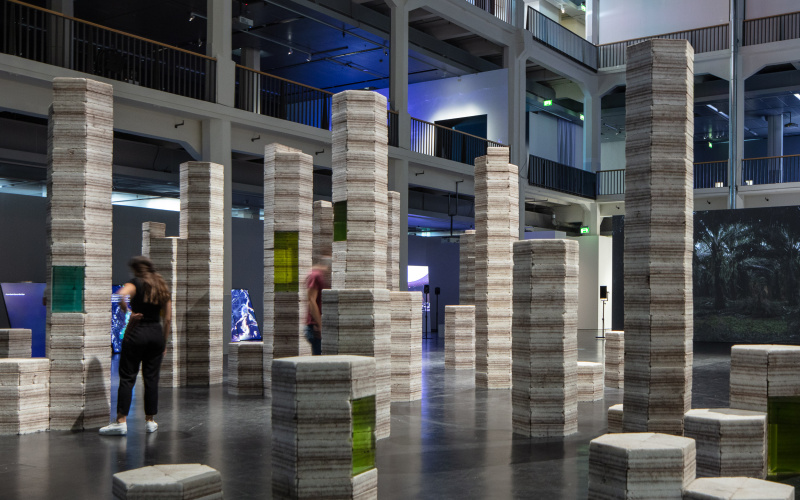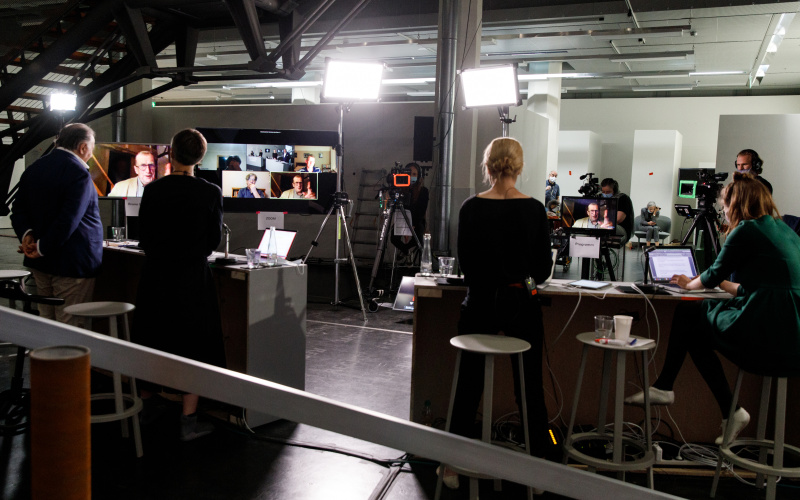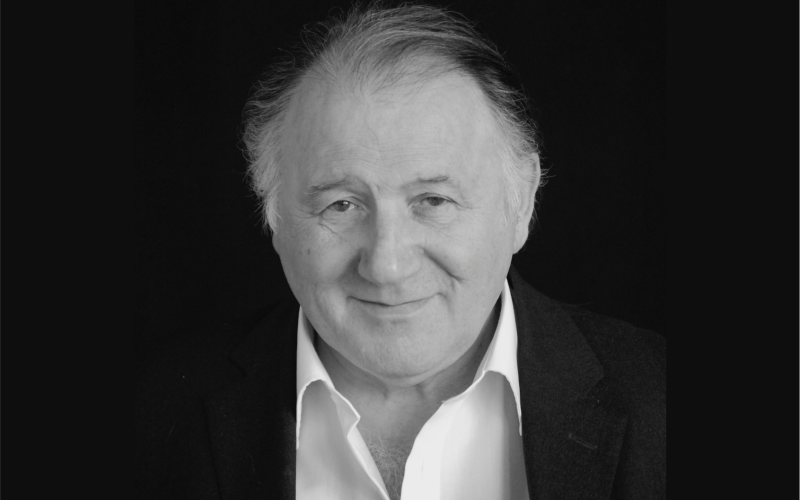From White Cube to Black Block
In the Western world, post-1945 and contrary to the political appropriation of the topic during the Third Reich and in the Eastern Bloc countries, the consensus was that Modern art was abstract art. To exaggerate the case polemically: it was limited to spreading color on canvases and to the formal design of objects that stood only for themselves and were presented in a neutral gallery space – the White Cube. This unilateral thrust was the product, or so it later emerged, not only of committed efforts by Modern artists such as Willi Baumeister, who defended Modernism, for example, against cultural historian Hans Sedlmayr and artist Karl Hofer, but also of organizations such as the Congress of Cultural Freedom, financed and directed by the CIA. The fact that modern art was considered progressive also had to do with the fierce opposition put up by conservative circles.The same pieces that once kindled utopian expectations are now to be found as precious objects decorating the walls of bank offices and private residences. When the Berlin Wall came down in 1989 the counter-model disappeared – the model from which Western art had sought to set itself off. Artists from other parts of the world demanded entry to an art system whose preconditions they did not always share. The purported end of history also created a political vacuum. In a media world dominated by particularist interests there is no appropriate representation of key problematic issues. In the functional systems of politics, business, science, and law, which according to Niklas Luhmann obey distinct intrinsic logics of their own, over-arching issues do not get considered.These disastrous trends can only be countered in two areas: in civil society and in art – or at least insofar as the latter has exited the White Cube and intervenes in social processes. In this case, art and activism blend seamlessly. Art is intended to render things visible, to question existing visual worlds and create new ones. Artistic activities can support citizens’ initiatives and NGOs or function independently: with performances in public spaces or employing a variety of media such as video, photography, comics, blogs, or Street art. Images from other regions of the world round out a person’s local experiences, for which there is no substitute as a reality check. During the protest movement against the railway and urban development project centering on the restructuring of Stuttgart’s main railway station (“Stuttgart 21”), the art group SOUP (Stuttgarter Observatorium urbaner Phänomene [Stuttgart’s observatory of urban phenomena]) set up a container in the Mittlerer Schlossgarten park, in close proximity to the station. Attached to an older artwork, Thomas Lenk’s Stuttgarter Tor [Stuttgart’s Gate], it initially functioned as a camera obscura, which – once the eyes had spent about 20 minutes adjusting to the darkness – revealed the station tower standing upside down. Yet over and above its metaphorical implications, before long the container was called Unser Pavillon [Our Pavilion] and functioned as the hub of the civil protest movement. A key factor in this was the darkness of the Black Box, that quality of not-yet-knowing how things will pan out. Independently of this, the artist duo Bankleer also focused on this process in one of their pieces. Referring to Kazimir Malevich’s Black Square, several actors concealed inside a cube made of black fabric took part in a demonstration in Aarhus on 1 May 2008. From inside the cube came the sounds of choirs and horns, although no players were visible. The “Black Block” toyed with the threatening dimension that uncontrollable protests possess for those in power: an image of the intrinsic momentum of civil movements that are open-ended.
From the Green Revolution in Iran to the silent protests in Belarus, the Arab Spring in Tunisia, Egypt, Senegal, and other countries, Occupy Wall Street in New York, the Indignados movement in Spain, the protests in Greece against austerity measures and the recent uprisings in Turkey and Brazil, world-wide protests against authoritarian regimes and austerity measures have gradually gained momentum. Today, nobody can offer a patent solution as Karl Marx once did with his call for a “dictatorship of the proletariat.” Given the global economic and ecological upheavals, there is all the more reason why all creative forces are now called upon to wade in. The problems differ from one country to the next, from one region to the next, but there is also much that unites them. This blog is intended to function as an additional black box, a space in which unforeseeable things happen. We want to offer a platform for dialog on a diversity of themes, such as public space, the large central urban plazas, the role of art and its institutions, the function of the media – and encourage artists, protagonists, and observers of the movements in the different regions of the world. In the hope that this will foster debate.
Text: Dietrich Heißenbüttel
All articles of the blog discussion on “global aCtIVISm" Further information on: www.global-activism.de About the author Dietrich Heißenbüttel studied literature (Italian, English, French, and Francophone literature) and history of art. His PhD thesis was on medieval frescoes in southern Italy. Since 1996 he has been making radio programs on jazz and improvised music for FRS, an independent radio station in Stuttgart. He also works for various daily newspapers and specialist journals (springerin – Hefte für Gegenwartskunst, Neue Zeitschrift für Musik, KONTEXT Wochenzeitung etc.). His main subjects are globalization, contemporary art, new music, architecture, and transport policy. Dietrich Heißenbüttel was the recipient of scholarships at the Bibliotheca Hertziana in Rome and the Akademie Schloss Solitude in Stuttgart. From 2005 to 2006 he moderated an intercultural composers’ workshop, Global Interplay, at the ISCM World New Music Festival. He has taught at the University of Stuttgart’s History of Art Institute since 2008. In 2010 he was co-curator of the exhibition, Friedensschauplätze / Theater of Peace for the Neue Gesellschaft für bildende Kunst (nGbK) in Berlin. Dietrich Heißenbüttel has written numerous articles on the subject of art and conflict for various publications. He is also active in the campaigns to preserve the University of Stuttgart’s History of Art Institute and Stuttgart’s main railway station. Selected publications: - Dietrich Heißenbüttel, Ungleiche Voraussetzungen. Zur Globalisierung der Künste, edited by Julia Warmers, Merz & Solitude, Stuttgart, 2008. - Dietrich Heißenbüttel (ed.), Kunst in Stuttgart. Epochen, Persönlichkeiten, Tendenzen, Hampp, Stuttgart, 2013. - nGbK (ed.), Friedensschauplätze. Frieden und Sichtbarkeit in der asymmetrischen Welt, exhib. cat., Friedensschauplätze / Theater of Peace, nGbK, Argobooks, Berlin, 2010 (co-editor and co-author). - Kimberly Bradley, Karin Käsböck, Christoph Leitner, Nataša Ilić, Dietrich Heißenbüttel, Stefan Kaegi, and Daniela Stöppel, Bankleer: Finger in the Pie, Sternberg Press, Berlin, 2012 (editorial work and catalog texts). - Simone Tippach-Schneider and Manfred Schweiker (eds.), Diva & Heldin. Frauenbilder in Ost und West, Palmedia, Berlin, 2012 (co-author). - Identitäten. Einige Überlegungen zum Werk von Fareed Armaly (essay for a book on the artist, in preparation). www.artwritings.de
Category
News Category
- tracks & records
